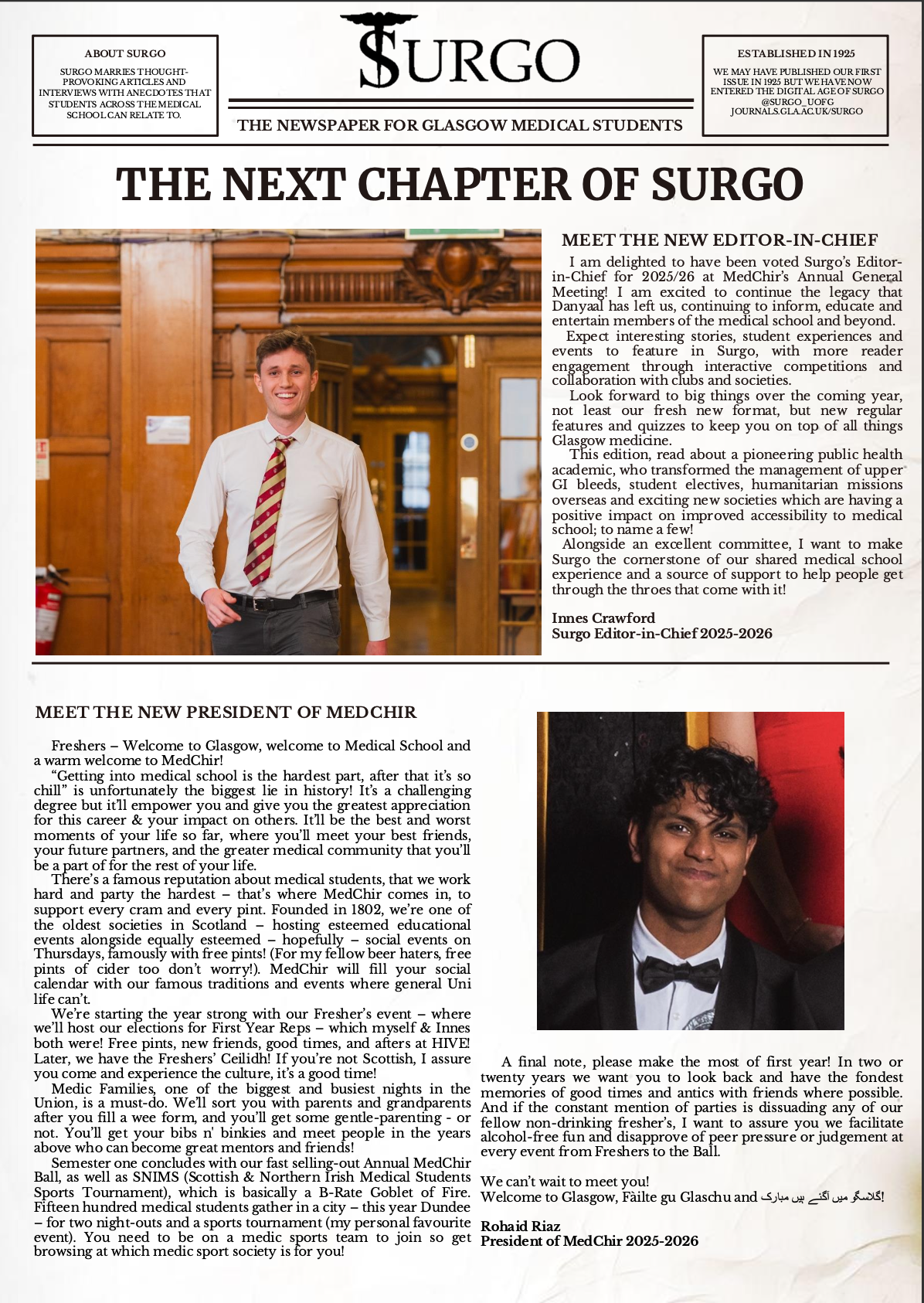Medical Uncertainty Guided By The Arts
DOI:
https://doi.org/10.36399/Surgo.3.649Abstract
The high level of assuredness expected of doctors in making life-altering decisions for their patients is juxtaposed with the inherent uncertainty in medicine. Medics must learn to navigate this uncertainty when faced with the everyday trials of balancing resource limitations, diagnostic uncertainty, ethical and social complexity, and multi-morbidity.
When confronting uncertainty in medicine, even at the rudimentary stage of a medical student, there is implicit understanding that we are opening ourselves up to the increased risk of making errors that could have lasting impact on our patients.
With this in mind, I was intrigued, and somewhat sceptical, when presented with the opportunity to undertake an elective in medical humanities, exploring how clinical uncertainty can be managed through the arts and wider humanities. Throughout the four-week elective, there was exposure to an array of disciplines including theatre, music, photography, ethics, and politics.
Among the many experts sharing knowledge of their respective fields was Professor Strazzacappa, who facilitated a week-long workshop of Medical Education Empowered by Theatre (MEET), which serves as a compulsory component of the medical curriculum at the University of Campinas in São Paulo, Brazil1.
The concept of MEET is founded on Boal’s Theatre of the Oppressed and Freire’s Critical Pedagogy1.These ideologies have been amalgamated to foster a learning environment of mutual respect that allows medical students to reflect upon, action change and resolve complex social scenes, often rooted in uncertainty, within the safe space of theatre1. Planning such scenes and improvising the performance in front of an audience, with no previous drama background, was both challenging and oftentimes uncomfortable. Feeling exposed, and subject to the analysis of others while performing incited vulnerability, not dissimilar to that experienced by patients who are also submitted to watchful observation in unfamiliar environments.
Aside from allowing us to better empathise with our patients, the self-directed nature of theatre improvisation required ongoing reflection and cognisance of how performance and communication can be attuned to meet the demands of complex, evolving situations and dialogue1. By employing the theatre-instilled practices of improvisation, awareness of stage presence and continuous self-assessment, we found ourselves more equipped to react and adapt to the fast-paced unpredictability of clinical practice, and action a collective approach to managing medical uncertainty1.
The elective was also useful in identifying a widespread variance in the interpretations of art amongst a group of medics. This disparity in opinions prompted healthy debate, receptivity to others’ perspectives and ultimately, reluctant recognition that art’s subjective nature means no one individual’s interpretation can be ‘correct,’ but rather shaped by our own individual experiences. Embracing this subjectivity allowed us to acknowledge that medical complexity cannot always be met with linear strategy or a definitive solution, and that accepting this is a step towards resolution in itself.
Art harbours hidden depth in that it relays meaning beyond words. As such, it can prove challenging to interpret what message the artist intends to convey. Navigating this uncertainty draws upon lateral thinking, introspection and consideration of how individual elements come together to evoke a response from the observer. The application of this reflective process to medical contexts aids in the holistic interpretation of a patient’s overall clinical picture where the initial presentation is multi-faceted, and the diagnosis is unclear.
While the underpinning of medicine follows an objective, evidence-based approach, the fundamental “human” core is where its innate subjectivity lies. Both patients and doctors are real people, whose unique experiences shape their perceptions, interactions, decisions and expectations of clinical care. These positions do not always align, and as such, an appreciation of the arts allows us to work alongside this subjectivity, rather than focus on the variables we cannot control.
While the arts cannot eliminate the inherent uncertainty in medicine, nor diminish the cruciality that sound textbook knowledge and clinical competence hold, insight into their subjectivity and an awareness of the parallels within medicine allows for acceptance and reconciliation of the everyday variables and uncertainty doctors must negotiate.
Overall, the elective showcased that the dichotomy between art and science is bridged in medicine. When the lessons of each are applied to clinical contexts, the pair form a mutualistic relationship in which the subjectivity of the arts coupled with the objectivity of science serve as a medical gateway to balanced decision making, well-informed professional reflection and therapeutic patient interactions.
Widespread integration of arts-based learning within existing medical curricula could take form by means of similar modalities to MEET, exploration of anatomy and clinical presentations through illustrative work, or reflecting on medical encounters via creative outlets such as writing or drawing. Widening the modalities through which medical education is delivered could augment critical thinking and affirm a sense of professional identity among students, ultimately facilitating a rise in doctors armoured with the framework to capably navigate a future career of uncertainty in medicine. No AI was used in writing this article.
Reference:
1. de Carvalho Filho MA, Ledubino A, Frutuoso L, da Silva Wanderlei J, Jaarsma D, Helmich E, Strazzacappa M. Medical Education Empowered by Theater (MEET). Acad Med. 2020 Aug;95(8):1191-1200. doi: 10.1097/ACM.0000000000003271. PMID: 32134785.


